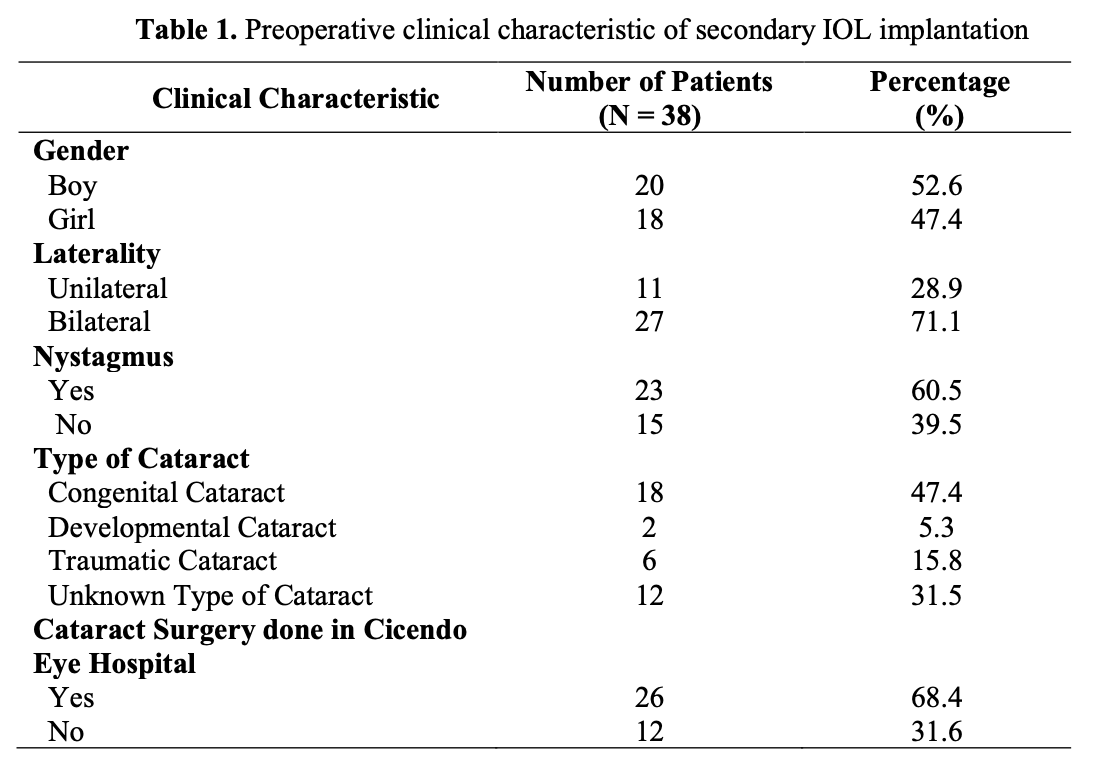Characteristic of Secondary Intraocular Lens Implantation in Aphakic Children in Cicendo National Eye Hospital
Abstract
Background: Pediatric cataract is responsible for 200.000 of preventable blindness in children. Early cataract extraction and correction after the lens removal is critical. Secondary intraocular (IOL) implantation might be considered when the child is intolerant to contact lenses/spectacle wear. Only a few study has been done regarding secondary IOL implantation in aphakic children.
Objective: This study was aimed to describe the characteristic of secondary IOL implantation in aphakic children in Cicendo National Eye Hospital.
Methods: This retrospective observational study took samples from medical records of patients who underwent secondary IOL implantation in 2016 – 2020 in Cicendo National Eye Hospital.
Results: Fifty nine eyes of forty pediatric patients underwent secondary IOL implantation surgery between 2016 – 2020. Two patients were excluded. From the 38 patients, 56 eyes were observed. Total of 20 patients were boys (52.6%) and 71.1% cases were bilateral cataract with congenital cataract as the main initial diagnosis (47.4%). Mean age of secondary IOL implantation was 71 ± 35 (20–201) months. Mean duration between cataract surgery and secondary IOL implantation was 51 ± 36 (2 – 189) months . Total of 80.4% of the IOL were fixated in the sulcus. Only 25% remained present for more than 12 months follow up and 65.8% of patients were corrected with bifocal spectacles.
Conclusion: Secondary IOL implantation in aphakic children were mostly done in the age of six years old. Most of the IOL were fixated in the sulcus. Patients were mostly given bifocal spectacles.
Full text article
References
AAO. Pediaric Cataract - Europe [Internet]. 2015. Available from: https://www.aao.org/topic-detail/pediatric-cataract-europe
Medsinge A, Nischal KK. Pediatric cataract: Challenges and future directions. Clin Ophthalmol. 2015;9:77–90.
Lambert SR, Lynn MJ, Hartmann EE, DuBois L, Drews-Botsch C, Freedman SF, et al. Comparison of contact lens and intraocular lens correction of monocular aphakia during infancy: A randomized clinical trial of HOTV optotype acuity at age 4.5 years and clinical findings at age 5 years. JAMA Ophthalmol. 2014;132(6):676–82.
Lambert SR, Aakalu VK, Hutchinson AK, Pineles SL, Galvin JA, Heidary G, et al. Intraocular Lens Implantation during Early Childhood: A Report by the American Academy of Ophthalmology. Ophthalmology [Internet]. 2019;126(10):1454–61. Available from: https://doi.org/10.1016/j.ophtha.2019.05.009
Trivedi RH, Wilson ME, Facciani J. Secondary intraocular lens implantation for pediatric aphakia. J AAPOS. 2005;9(4):346–52.
Koch CR, Kara-Junior N, Serra A, Morales M. Long-term results of secondary intraocular lens implantation in children under 30 months of age. Eye [Internet]. 2018;32(12):1858–63. Available from: http://dx.doi.org/10.1038/s41433-018-0191-3
Rong X, Ji Y, Fang Y, Jiang Y, Lu Y. Long-term visual outcomes of secondary intraocular lens implantation in children with congenital cataracts. PLoS One. 2015;10(7):1–10.
Mohamed T, Eldin Zaki R, Hashem M. Primary versus secondary intraocular lens implantation in the management of congenital cataract. J Egypt Ophthalmol Soc. 2016;109(2):54.
Nihalani BR, Vanderveen DK. Secondary intraocular lens implantation after pediatric aphakia. J AAPOS [Internet]. 2011;15(5):435–40. Available from: http://dx.doi.org/10.1016/j.jaapos.2011.05.019
Romadhon AS, Susanto J, Loebis R. The Comparison of Visual Acuity After Congenital Cataract Surgery between Children ?2 Years and >2-17 Years. Biomol Heal Sci J. 2020;3(2):70.
Rahi J, Dezateux C. Measuring and Interpreting the Incidence of Congenital Ocular Anomalies: Lessons from a National Study of Congenital Cataract in the UK. Invest Ophthalmol Vis Sci. 2001;42:1444–8.
Wood KS, Tadros D, Trivedi RH, Wilson ME. Secondary intraocular lens implantation following infantile cataract surgery: Intraoperative indications, postoperative outcomes. Eye [Internet]. 2016;30(9):1182–6. Available from: http://dx.doi.org/10.1038/eye.2016.131
AAO. Pediatric Ophthalmology and Strabismus. Acad Med. 2020;7(4):286.
DeVaro JM, Buckley EG, Awner S, Seaber J. Secondary posterior chamber intraocular lens implantation in pediatric patients. Am J Ophthalmol [Internet]. 1997;123(1):24–30. Available from: http://dx.doi.org/10.1016/S0002-9394(14)70988-2
Enyedi LB, Peterseim MW, Freedman SF, Buckley EG. Refractive changes after pediatric intraocular lens implantation. Am J Ophthalmol. 1998;126(6):772–81.
Moore DB, Ben Zion I, Neely DE, Roberts GJ, Sprunger DT, Plager DA. Refractive outcomes with secondary intraocular lens implantation in children. J AAPOS [Internet]. 2009;13(6):551–4. Available from: http://dx.doi.org/10.1016/j.jaapos.2009.09.012
Zue X, Xin X, Zao X, Gong X. Comparison of effects of secondary in in-the-bag and sulcus intraocular lens implantation in pediatric aphakia after congenital cataract operation. Zhonghua Yan Ke Za Zhi. 2013 Aug;49(8):700-5.
Authors
Copyright (c) 2022 Lina Sudaryo

This work is licensed under a Creative Commons Attribution-NonCommercial-ShareAlike 4.0 International License.

